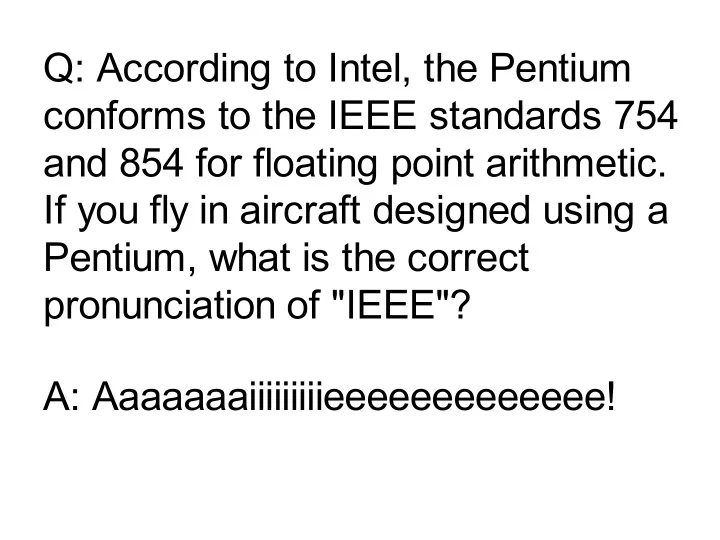

Q: According to Intel, the Pentium conforms to the IEEE standards 754 and 854 for floating point arithmetic. If you fly in aircraft designed using a Pentium, what is the correct pronunciation of "IEEE"? A: Aaaaaaaiiiiiiiiieeeeeeeeeeeee!
Advanced Java Class Web Applications – part 2 (JSPs, etc.)
JSPs (Java Server Pages) • What are they? – When you’re editing it: HTML that contains java code After it’s compiled: a Servlet – – What the client computer receives: just HTML
JSPs (Java Server Pages) • Functionality – The java part is pre-processed on the server side, so the client never knows the difference. – Functionality is interchangeable with servlets – By the time they reach the user, they are HTML, so JavaScript & applets still have a place in enhancing user experience.
Advantages of using a combination of JSPs & servlets • can use WYSIWYG editor, and write HTML directly. • nonprogrammers can write the HTML parts of a JSP page • cleaner than using either alone
JSPs and MVC Layers • Ideally, the View layer is accomplished by passing a JavaBean to the JSP, and then the only java code in the JSP is the display code of showing those values. • The Controller layer is then left to the Servlet and it’s helper classes • And the Model layer is implemented by other class that are also on the server side. • See figure 13-12 on page 858.
JSP tags & API (fig. 13-13) • Ultimate Goal: limit actual Java code in JSPs, so that people who don’t know how to program can edit and create the view layer of the application (i.e. graphic designers) – How to do this: • Javabean tags, custom tag libraries – Okay compromises: • Scriptlets, Expressions
JSP as HTML or XHTML • Comments: <%-- comment --%> • Directives: <%@ … %> – Page ex.: <%@ page import= “java.util.*” %> Include ex: – <%@ include file= “global_header.html” %> • Declaration ex: <%! Type fieldname=expression; %> • Expression: <%= expression %> • Scriptlet: <% for (…) {…} …int i=5;…%>
JSPs as XML Documents • Benefits: – can validate with dtd spec files – Can create and edit with code • Bad effects: – Appear a little more complex – A little longer
JSPs as XML Documents – Syntax (fig. 13-15) • <jsp:root>…</jsp:root> • <jsp:directive.page import=” value ” /> • <jsp:directive.include file=”filename” /> • <jsp:text>….</jsp:text> • <jsp:declaration>…</jsp:declaration> • <jsp:expression>…</jsp:expression> • <jsp:scriptlet>…</jsp:scriptlet> • <jsp:forward page=”URN”/>
JSP as XML Syntax, continued • beans – <jsp:plugin type=”bean | applet”…/> – <jsp:usebean id=”instance” scope=”page | request | session | application” type=”className”> – <jsp:getProperty name=”bean” property=”field” /> – <jsp:setProperty name=”bean” property=”field” value=”value”> • custom libraries – <tagPrefix:customtag attribute=value… />
Server Processing 1. HTML, XHTML, or XML page -> java source file that defines a Servlet class 2. java class compiled to byte code 3. run the resulting servlet Note: If you change a jsp, the web server will automatically recompile it and show it to you when you reload the page. In other words, you don’t have to restart tomcat if you change a jsp. (You do have to restart tomcat if you recompile java code.)
Predefined Variables in JSP • request (argument to doGet/doPost) • response (argument to doGet/doPost) • pageContext • session (request.getSession()) • application (getServletConfig().getContext()) • out (PriterWriter that writes to response outputStream) • config • page (like “this”)
JSP tags for JavaBeans • Good for taking code out of the view layer, so that non-programmers can create/edit the view layer • Three relevant tags: – Usebean – will try to look up in scope, or will instantiate. Class must have a no-args constructor – getProperty, setProperty – will access a get/set method with the corresponding name – make sure it’s there – these match the XML syntax, but can also be used in HTML/XHTML • See Chapter 8 for more details (not covered).
Custom Tags – a mere intro • The Ultimate Step in taking code out of the jsp page • You can define your own tags that define more interesting functionality, such as for loops, if statements, & other code blocks. • They can have attributes that you use to pass variables into the scope of the custom tag Declaring a library: • – <%@ taglib uri=”…” prefix=”…” %> – <jsp:root … xmlns:myPrefix=”…” …>..</jsp:root> • Syntax for using a tag: <libraryPrefix:tagName … /> • Some predefined libraries: – Sun Microsystems JSP Standard Tag Library (JSTL) – Jakarta Taglibs is a free implementation of JSTL – http://jakarta.apache.org/taglibs
Building Robust Web Apps • Make Servlets thread-safe • Allow for the fact that users do weird things • Use relative addresses within your app.
Multithreading • There is one instance of the Servlet running in the web app, but it is being accessed by a different thread for each client • Your variables must be thread-safe – Don’t use fields of servlet as working storage – use session or request scope instead, because each client has a separate session and request – local variables are thread-safe if only one client at a time should run a method, – declare it synchronized
Users Can... • press BACK and FORWARD buttons, rather than using your carefully created navigation buttons • bookmark a page in the middle of your site and go straight there, instead of via the flow you designed • get impatient and click “submit” many times.
What you can do about what users can do... • Turn off caching for pages with dynamic content. • Check for validity of needed session attributes, and redirect to login if they aren’t there. • Disable buttons (using JavaScript) as soon as they are pressed the first time.
Use Relative Addresses If you use relative addresses within web pages, you can switch: – protocols – hosts – domain names – ports Without having to change your internal links!
Recommend
More recommend